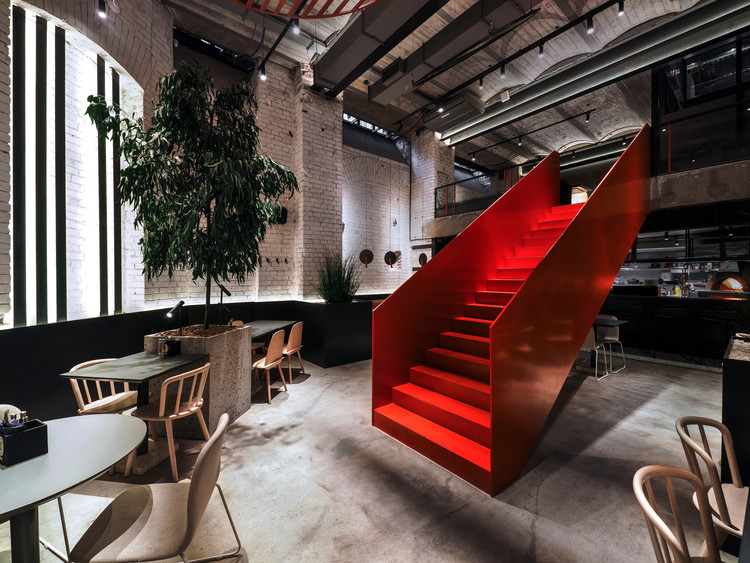Institute of Advanced Study of the University of Amsterdam HOH Architecten
2018-02-12 02:00
© Jordi Huisman
乔迪·惠斯曼


架构师提供的文本描述。阿姆斯特丹大学高级研究所是一个跨学科研究中心,汇集了年轻的国际科学家,以产生想法、扩大知识和发展新的研究方法。生物学家、社会学家和经济学家在气候变化、移民和金融危机等问题上共同努力。此外,还邀请诺贝尔奖获得者讨论紧迫的跨学科问题。
Text description provided by the architects. The Institute for Advanced Study (IAS) of the University of Amsterdam is a centre for interdisciplinary research and brings together young international scientists to generate ideas, broaden knowledge and develop new research methodologies. Biologists, sociologists and economists work together on topics such as climate change, immigration and financial crises. In addition, Nobel Prize laureates are invited to discuss urgent interdisciplinary issues.


国际机场搬进了位于阿姆斯特丹市中心的OudTurfmarkt(145号和147号)上的两座运河房屋。这两座建筑是由著名的17世纪建筑师飞利浦·温布恩于1642年设计的,并以相同的双人间形式建造。然而,这对双胞胎在出生时就分开了。不同的用途和不同的业主留下了他们的足迹在建筑物。147号的正面甚至在1882年被完全取代。当HOH建筑公司开始在这个项目上工作时,没有墙壁,地板或天花板装饰是相同的。人们可以说,这些建筑物已经缩小为一个集合的房间,其中总是有两个相同的比例,一个在145号和一个在147号。
IAS moves into two canal houses on the Oude Turfmarkt, no. 145 and no. 147, in the very heart of the Amsterdam city centre. The two buildings were designed by the famous 17th century architect Philips Vingboons in 1642 and built as identical twin houses. The twins were separated at birth however. Different use and different owners left their tracks in the buildings. The facade of no. 147 was even completely replaced in 1882. No wall, floor or ceiling finishing was identical anymore when HOH Architecten started to work on the project. One could say the buildings had been reduced to a collection of rooms of which there are always two with the same proportions, one in no. 145 and one in no. 147.
© Jordi Huisman
乔迪·惠斯曼


通过将这两座建筑改建成IAS的新家,这对双胞胎在三个半世纪后,在身体上和程序上都重聚在了一起。丰富的建筑历史为建筑转型提供了启示。建筑物的镜像,连续的建筑和重建,一层层,一代又一代,是处所DNA的一部分。这给了HOH一本手册,有时可以重建房间的一部分,但也从根本上干预了新功能要求的任何地方。
By converting the two buildings into the new home of IAS the twins are physically and programmatically reunited after three and a half centuries. The rich history of the buildings formed an inspiration for the architectonical transformation. The mirroring of the buildings, the continuous building and rebuilding, layer upon layer, generation by generation, is part of the DNA of the premises. This gave HOH a handbook to sometimes reconstruct parts of the rooms but also radically intervene wherever the new function asked for it.




另一个灵感来源是新用户。在设计中,还作为空间原则,反映、重新定义和发现IAS期望其科学家提供的特性。实体与视觉、旧与新、现实与感知之间的架构游戏必须确保用户和访问者都需要重新定义他们的交互、工作和协作方式。
Another source of inspiration was the new user. Reflecting, redefining and discovering, characteristics that IAS expects from its scientists are also introduced as spatial principles in the design. An architectural play between physical and visual, old and new, reality and perception must ensure that both users and visitors need to redefine their way of interacting, working and collaborating.
© Jordi Huisman
乔迪·惠斯曼


Hoh一直致力于他们在每个房间中发现的品质,以及在建造过程中给他们带来了什么。因此,国际建筑学会没有获得一种占主导地位的住宅风格,而是成为不同风格的组合,每个房间都是独特的,符合新的功能,具有自己的物质性和氛围。国际会计准则正是通过不同风格、不同用户和不同领域的相互作用,获得了自己的认同,在多样性中找到了统一性。
HOH has worked with the qualities they found per individual room and what came to them during the construction process. As a result, IAS has not acquired one dominant house style, but has become a mix of different styles, each room being unique and attuned to the new function and with its own materiality and atmosphere. Precisely through the cross-fertilization between different styles, users and spheres, IAS has acquired its own identity and unity was found in diversity
© Jordi Huisman
乔迪·惠斯曼






























































Architects HOH Architecten
Location Oude Turfmarkt, 1012 Amsterdam,The Netherlands
Project Team Freyke Hartemink, Carsten Hilgendorf, Jarrik Ouburg, Matteo Oldini, Julio Tamma
Area 600.0 m2
Project Year 2017
Photographs Jordi Huisman
Category Adaptive Reuse
Manufacturers Loading...
























